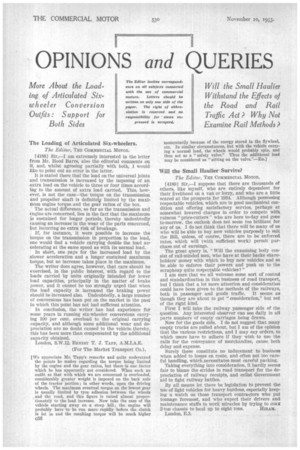OPINIONS and QUERIES The Loading of Articulated Six-wheelers.
Page 86

If you've noticed an error in this article please click here to report it so we can fix it.
The Editor, TOE COMMERCIAL Moron.
[4188] Sir,—I am extremely interested in the letter from Mr. Hood Barra, also the editorial comments on it, and, whilst agreeing partially with both, I would like to point out an error in the latter.
It is stated there that the load on the universal Joints and transmission is Increased by the imposing of an extra load on the vehicle to three or four times according to the amount of extra load carried. This, however, is not the case—the torque on the transmission and propeller shaft is definiteli limited by the maximum engine torque and the gear ratios of the box.
The actual difference, so far as the transmission and engine are concerned, lies in the fact that the maximum Is sustained for longer periods, thereby undoubtedly causing an increase in the wear of the parts concerned, but incurring no extra risk of breakage.
it, for instance, it were possible to increase the torque on the transmission in proportion to the load, one would find a vehicle carrying double the load accelerating at the same speed as with its normal load.
In short, one pays for the increased load by the slower acceleration and a longer sustained maximum torque, but no increase takes place in the maximum.
The writer does agree, however, that care should be exercised, in the public interest, with regard to the loads carried by units originally intended for lower load capacities, principally in the matter of brake power, and it cannot be too strongly urged that when the load capacity is increased the braking power. should be increased also. Undoubtedly, a large number of conversions has been put on the market in the past in which this point has not had sufficient attention.
• In conclusion, the writer, has had experience for some years in running six-wheeler conversions carrying 100 per cent, overload to the original carrying capacity, and although some additional wear and depreciation are no doubt caused to the vehicle thereby, this has been more than compensated by the additional capacity obtained.
London, &Viral ERNEST T. J. Tarp, A.M.I.A.E.
(For The Market Transport Co.).
IWe appreciate Mr. Tapp's remarks and quite understand the points he makes regarding the torque being limited by the engine and the gear ratios, but there is one factor which be has apparently not considered. When such an outfit as that with which we are concerned is overloaded, considerably greater weight is imposed on the back axle of the tractor portion; in other words, upon the driving wheels. The maximum eventual torque on the lowest gear is usually limited by tyre adhesion between the wheels and the road, and this figure is raised almost proportionately to the load increase. Now take the case of the vehicle starting away on a steep hill; the engine will probably have to be run more rapidly before the clutch is let in and the resulting torque will be much higher c56 momentarily because of the energy stored in the flywheel, etc. In similar circumstances, but with the vehicle carrying a normal load, the wheels would probably spin, and thus act as a "safety valve." Thus the additional load may be considered as "sitting on the valve."—En.] Will the Small Haulier%Survive?
The Editor, THE COMMERCIAL MOTOR.
[4189] Sir,—I suppose that there are thousands of others, like myself, who are entirely dependent for their livelihood on a van or lorry, and who are a little scared at the prospects for 1934. Although possessing respectable vehicles, which are in good mechanical conditioo and offering satisfactory service, perhaps at somewhat lowered charges in order to compete with ruinous " price-cutters " who are here to-day and gone to-morrow, the outlook does not seem too brilliant for any of us. I do not think that there will be many of us who will be able to buy new vehicles purposely to suit the Bill, unless, of course, there are to be enforced rates, which will (with sufficient work) permit purchase out of earnings.
The great query is, "Will the examining body consist of rail-minded men, who have at their backs shareholders' money with which to buy new vehicles and so be able to enforce their powers and push on to the scrapheap quite respectable vehicles?"
I am sure that we all welcome some sort of control and standardization in this business of road transport! but I think that a lot more attention and consideration could have been given to the methods of the railways, both in passenger and goods traffic. It seems as though they are about to get "consideration," but not of the right kind.
First I will take the railway passenger side of the question. Any interested observer can see daily in all Parts numbers of empty carriages being drawn.
Now for the goods side. I do not suggest that many empty trucks are pulled about, but I am of the opinion that the various restrictions, and I may say orders, to which users have to adhere if they wish to use the rails for the conveyance of merchandise, cause both delay and expense.
Sorely these constitute no inducement to business when added to losses en route, and often not too careful handling, which necessitates most careful packing.
Taking everything into consideration, it hardly seems fair to blame the strides in road transport for the depreciation of railway receipts, and enlist Government aid to fight railway battles.
By all means let there be legislation to prevent the 'use of light vehicles for heavy burdens, especially keeping a watch on those transport contractors who put tonnage foremost, and who expect their drivers and maintenance staffs to work miracles by trying to coax 2-ton chassis to haul up to eight tons. HIRAM. London, E.3.




























































































































